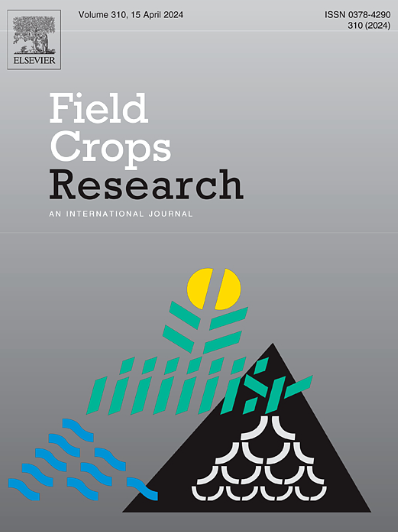灌浆期水稻颖果赖氨酸含量的变化及其对季中氮素管理的响应
IF 6.4
1区 农林科学
Q1 AGRONOMY
引用次数: 0
摘要
背景与问题赖氨酸(Lys)是水稻中第一限制性必需氨基酸,其在颖果中的生物合成受氮(N)管理的调节。然而,在灌浆过程中,早花期颖果(SCs)和晚花期颖果(ICs)中赖氨酸含量的时间动态及其在颖果各层间的分布尚不清楚。此外,sc和ic之间、水稻品种之间以及对季中施氮的响应中赖氨酸合成代谢的变化尚未完全阐明。目的研究(1)不同水稻品种籽粒灌浆过程中SCs和ICs中赖氨酸含量的变化;(2)研究灌浆过程颖果各层赖氨酸含量与糙米和精米最终赖氨酸含量的关系;(3)确定促进水稻籽粒赖氨酸生物合成的氮素管理措施。方法连续3年进行2次野外实验。第一个试验涉及在常规氮素管理下种植的6个水稻品种。第二个试验以2个有代表性的水稻品种为试验对象,试验了不施氮(N0)、穗初施氮(N1)、雌蕊分化(N2)和抽穗初施氮(N3) 4个季中施氮处理。结果籽粒灌浆过程中,籽粒中赖氨酸含量的峰值增长速率(PIR)较SCs低,且品种间存在差异。PIR高的品种成熟期赖氨酸积累量也高,尤其是ic品种。发育籽粒中、内层赖氨酸含量与成熟时精米与糙米赖氨酸的比例密切相关。参与赖氨酸生物合成的酶活性增强,而不是分解代谢,有助于更高的PIR和赖氨酸保留。季中施氮(N1 ~ N3)显著提高了糙米和精米的PIR、赖氨酸生物合成酶活性、赖氨酸和总氨基酸含量,同时提高了籽粒产量。N1和N2处理显著提高了精米中赖氨酸的比例,改善了稻米的口感品质,而N3处理则降低了这两种品质。结论灌浆过程中提高稻壳中、内层赖氨酸的PIR及其积累是提高精米赖氨酸含量的关键。穗分化期施氮可有效促进这一策略,同时提高粮食产量和食味品质。本研究为通过优化季中氮素管理提高水稻营养品质提供了一条实用途径,其重点是促进发育中籽粒赖氨酸的生物合成。本文章由计算机程序翻译,如有差异,请以英文原文为准。
Changes in lysine content in rice caryopses during grain filling and in response to mid-season nitrogen management
Context and problem
Lysine (Lys) is the first limiting essential amino acid in rice, and its biosynthesis in caryopses is regulated by nitrogen (N) management. However, the temporal dynamics of Lys content in earlier-flowering superior caryopses (SCs) and later-flowering inferior caryopses (ICs), as well as its distribution across caryopsis layers during grain filling, remains poorly understood. Moreover, variations in Lys anabolism between SCs and ICs, among rice varieties, and in response to mid-season N application have not been fully elucidated.
Objective
The study aimed to (1) characterize changes in Lys content in both SCs and ICs during grain filling across different rice varieties; (2) examine the relationship between Lys content in different layers of a caryopsis during grain filling and final Lys content in brown and milled rice; and (3) identify N management practices that enhance Lys biosynthesis in rice grains.
Methods
Two field experiments were conducted for three years. The first experiment involved six rice varieties grown under conventional N management. The second tested four mid-season N treatments, i.e., no N application (N0), N application at panicle initiation (N1), pistil and stamen differentiation (N2), and heading initiation (N3), using two representative rice varieties.
Results
Compared to SCs, ICs exhibited a lower peak increase rate (PIR) of Lys content during grain filling, with varietal differences observed. Varieties with higher PIR had higher Lys accumulation at maturity, especially in ICs. Lys content in the mid and inner layers of developing grains was closely associated with the proportion of Lys in milled rice relative to brown rice at maturity. Enhanced activities of enzymes involved in Lys biosynthesis, rather than catabolism, contributed to higher PIR and Lys retention. Mid-season N application (N1 - N3) significantly increased PIR, Lys biosynthesis enzyme activities, and Lys and total amino acid contents in both brown and milled rice, while also increasing grain yield. Notably, N1 and N2 increased the proportion of Lys in milled rice and enhanced taste quality, whereas N3 reduced both.
Conclusions
Boosting the PIR of Lys and its accumulation in the middle and inner caryopsis layers during grain filling is key to increasing Lys content in milled rice. N application during panicle differentiation effectively promotes this strategy while enhancing both grain yield and eating quality.
Implications
This study offers a practical approach to improving the nutrient quality of rice through optimized mid-season N management focused on enhancing Lys biosynthesis in developing grains.
求助全文
通过发布文献求助,成功后即可免费获取论文全文。
去求助
来源期刊

Field Crops Research
农林科学-农艺学
CiteScore
9.60
自引率
12.10%
发文量
307
审稿时长
46 days
期刊介绍:
Field Crops Research is an international journal publishing scientific articles on:
√ experimental and modelling research at field, farm and landscape levels
on temperate and tropical crops and cropping systems,
with a focus on crop ecology and physiology, agronomy, and plant genetics and breeding.
 求助内容:
求助内容: 应助结果提醒方式:
应助结果提醒方式:


